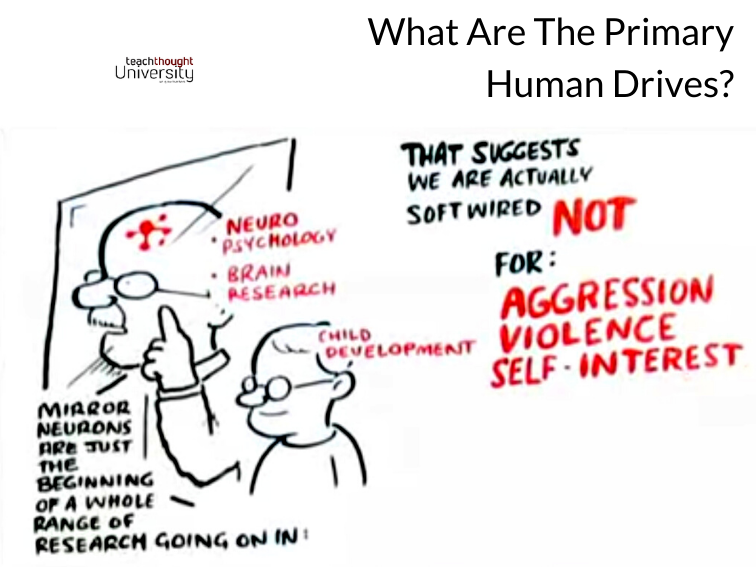
What Are The Primary Human Drives?
by TeachThought Staff
What exactly the primary human drives depend on who you ask. There are simply too many ways to frame the question to get a single answer every scientist and artist and parent and historian on earth would agree on.
But by studying neuroscience, we can begin to establish some common ground–which is what Jeremy Rifkin, American economic and social theorist, writer, and political advisor did in this RSA Animate video below.
When discussing how the brain is ‘wired,’ we generally are trying to understand how the brain ‘works’ so we can anticipate and adjust for its tendencies while taking advantage of what it does well while avoiding–or improving–the things it doesn’t. (See The Cognitive Load Theory, for example.)
In the video below (which has is now more relevant than ever), “The Empathic Civilization,” Rifkin explores how our brains are wired, explaining that we are “soft wired to experience another’s plight as if we are experiencing it ourselves” through mirror neurons.
This offers a different perspective than other neuroscience, historical, or cultural examinations might: one that uses the starting point of human suffering. Rather than implying the human race should ‘evolve’ towards a utopia that is free from suffering, he emphasizes the inescapability of our human limitations and concludes that a ‘higher’ civilization would be one that tended toward unity and interdependence through empathy (something I wrote about/around in The Source Of All Human Suffering).
We are not Home-sapien, he argues, but ‘Home-empathicus’–homonids whose brains tend toward empathy. By acknowledging suffering as impossible to avoid and exploring how suffering–as well as conflict, empathy, violence, love, etc.–can affect the way our brains are wired, we can see a more direct relationship between who we are and how we live. This, in turn, can inform our behavior in the present toward a more honest and neuroscience-based future.
Citing development in Evolutionary Biology, Neurocognitive Science, Child Development, and research in general, Rifkin compares early forager/hunters, medieval surfs, and the modern human being shaped quite differently, asking, ‘How does consciousness change in history?’ He also identifies some of the larger sociocultural factors and changes, including religion, war, and the fiction of ‘nation-states’ and nationalism. In short, our brains want us to belong to something and how that plays out depends on our context–our historical circumstance, for example.
The video is only ten minutes long and he explains it much more eloquently than I can. But broadly speaking, by focusing a broad, primal characteristic of our humanity–the need to belong–he provides a starting point for self-examination in a modern world much different than the ones that shaped our brains centuries ago.
In outlining this theory, he provides four fundamental human needs culminating in a ‘first drive’–the drive to belong.
What Are The Four Primary Human Drives?
According to Rifkin, the four primary human drives are:
Sociability
Attachment
Affection
Companionship
These needs align very neatly with what connectivity, social learning, and even pop social media platforms provide. This would imply that the need to selfie, like, and check-in, align yourself with certain brands, and other tech-habits may not be so much the result of weakness and addiction, but rather a serendipitous alignment between the way you’re wired and the features and design of prevailing local technology.
See also The Difference Between Empathy And Sympathy
Rifkin also focuses on the idea of empathy itself–examples, what it means, etc.–and finishes his talk offering another theory about what happens when these needs to connect, relate to, and belong are repressed. That is, when the primary drives fail, the following drives take over.
The video is now nearly a decade old and takes a fairly optimistic view of social media. He calls on us (partly through social media) to expand our identities from local and religious and national to a broader human narrative catalyzed through commonness–and empathy.
If we don’t? That’s where the ‘secondary’ human drives become a factor.
What Are Four Secondary Human Drives?
Narcissism
Materialism
Violence
Aggression
You can find the video here.